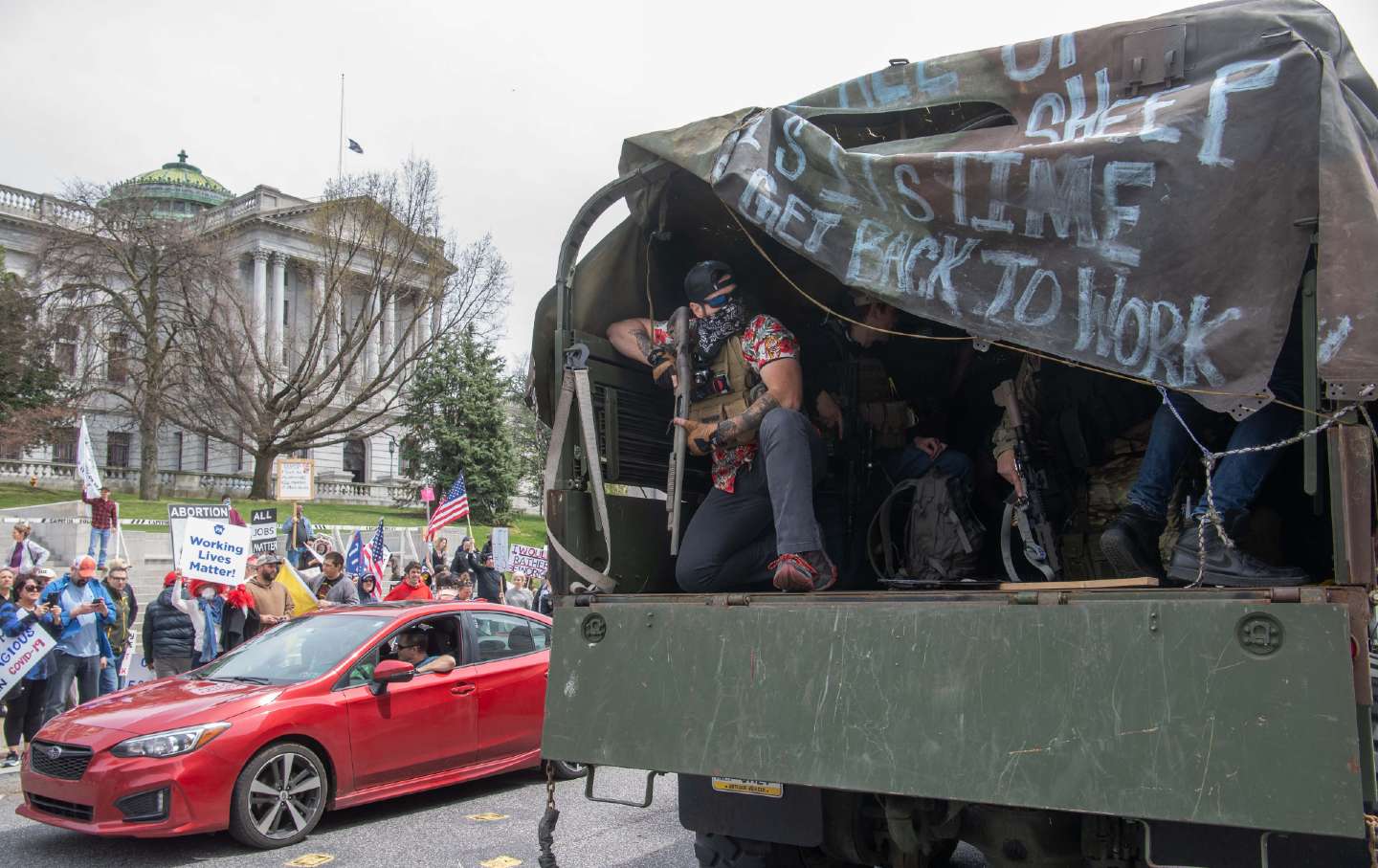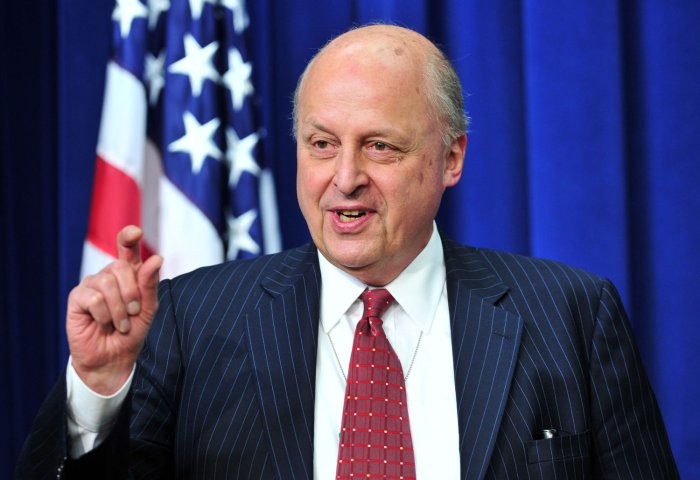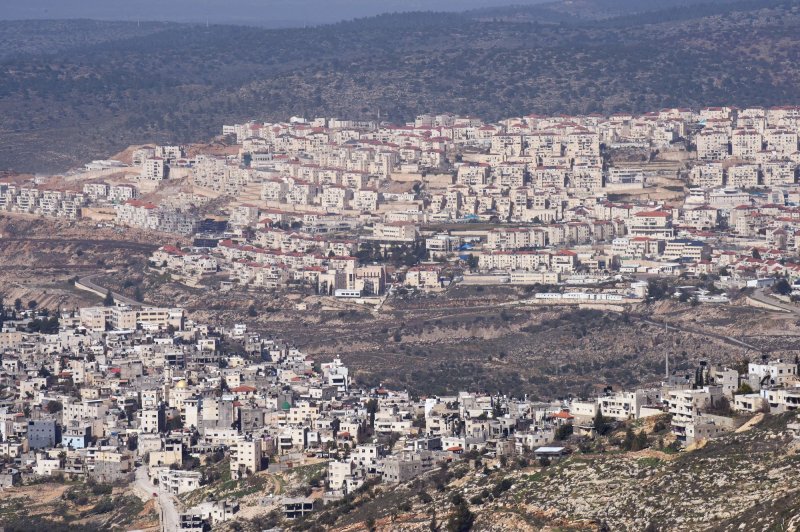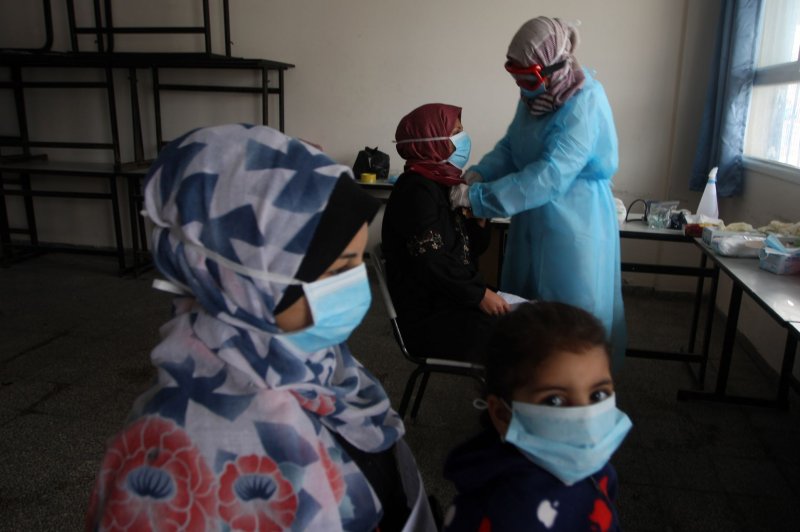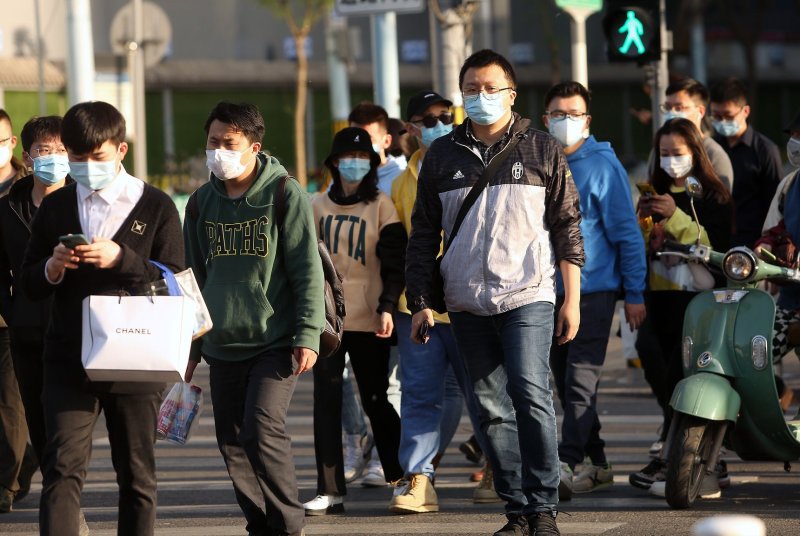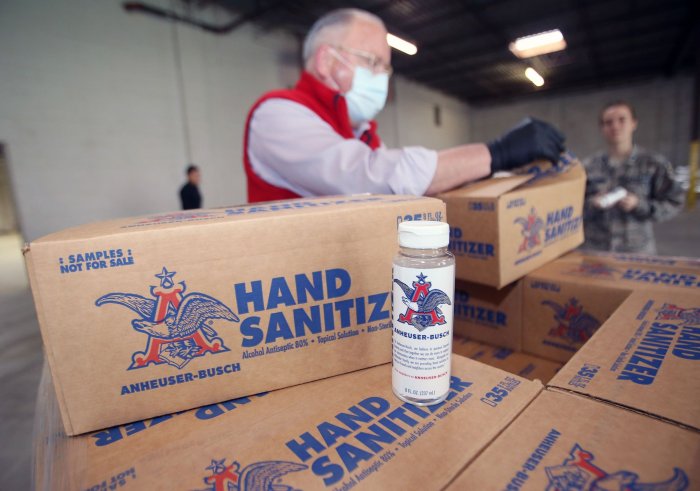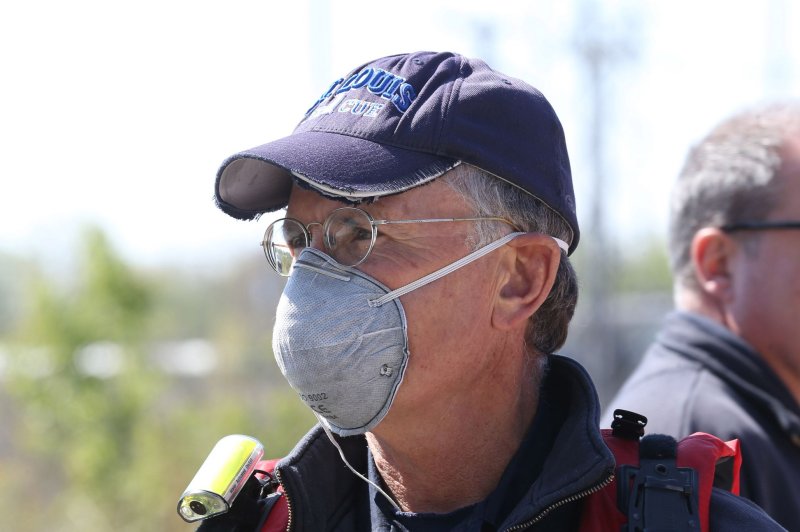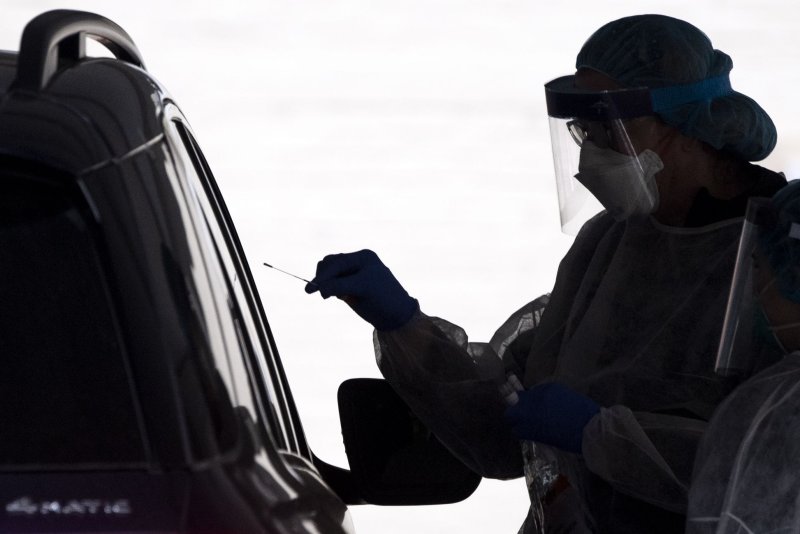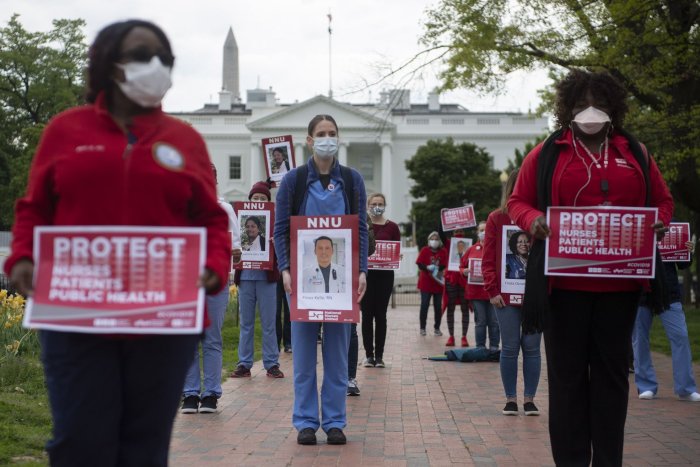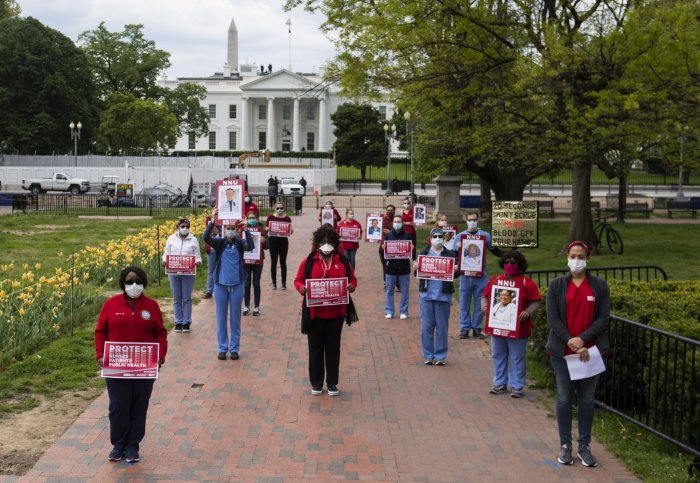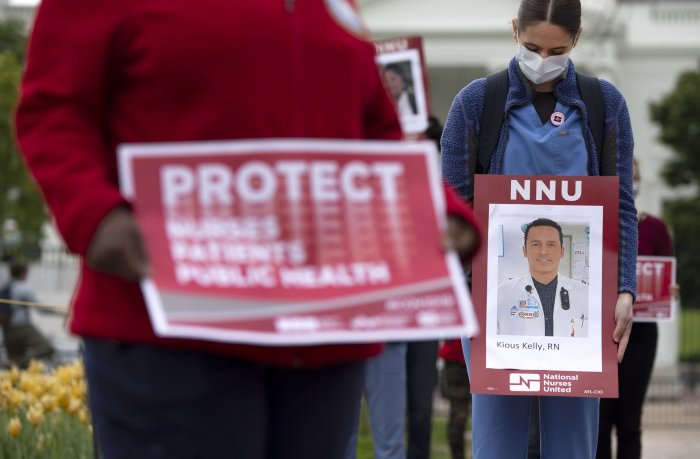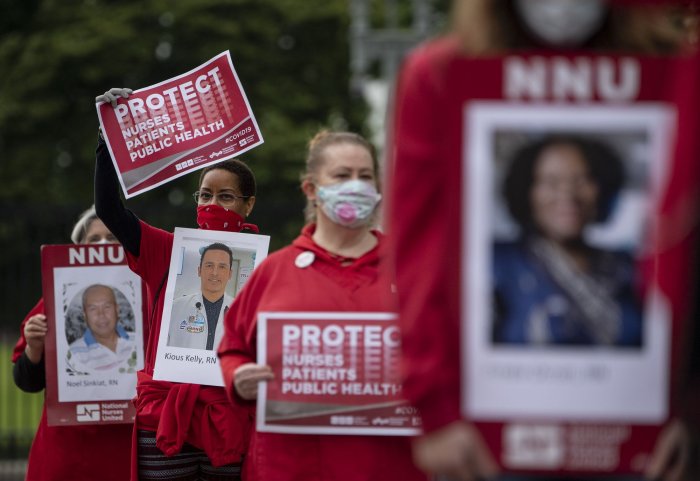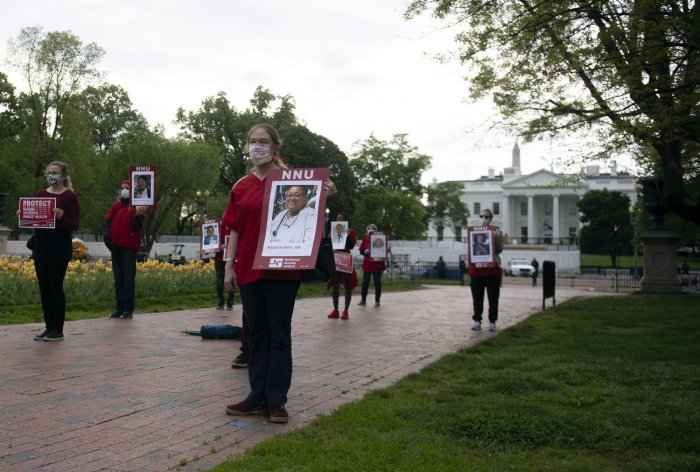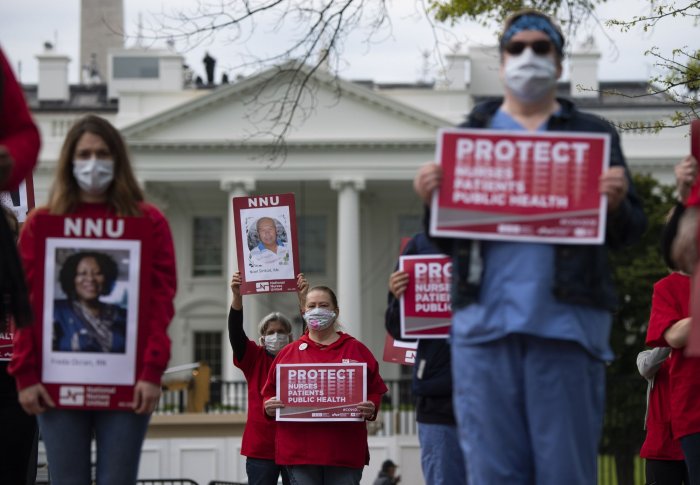Danielle Campoamor, Hello Giggles•April 22, 2020
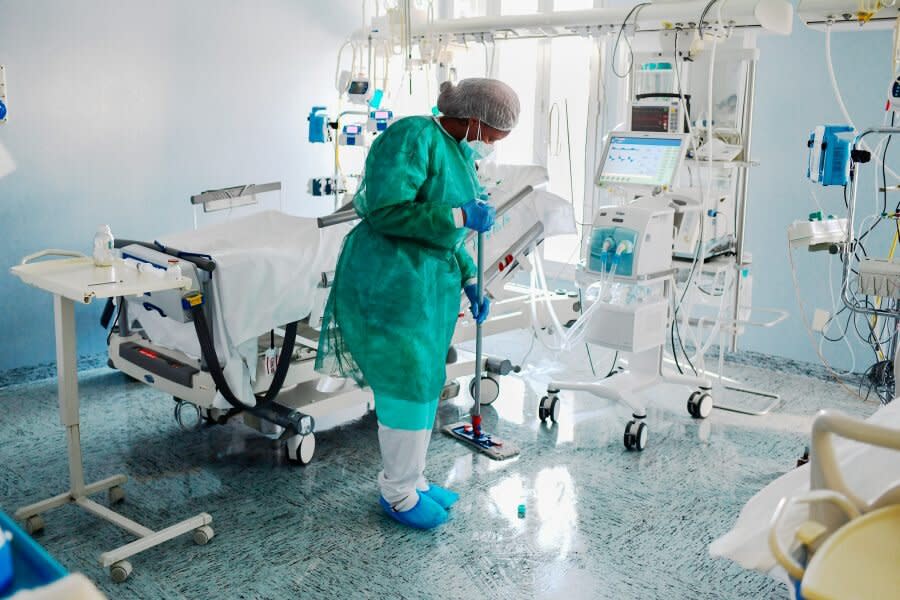
I’m standing in my kitchen in Brooklyn, New York, diligently stirring a pot of chicken risotto I’m dangerously close to burning, when I hear the sound of New York City’s new 7:00 p.m. ritual: people from their windows, balconies, and stoops, cheering on the healthcare professionals, hospital cleaners, and other essential employees battling the coronavirus (COVID-19) pandemic that, to date, has killed over 40,000 Americans. Sometimes the cheers are accompanied by songs, like “New York, New York.” Other times the cheers grow louder as an attempt to best the near-constant scream of sirens that permeate throughout the day; an audible act of defiance against a piercing reminder of the loss of lives happening around us.
But like the homemade signs my 5-year-old made that now hang in his bedroom window to show our appreciation to delivery people, sanitation workers, warehouse workers, doctors, nurses, and EMTs, there is one group of people contributing to the front line that are left out of the city’s 7:00 p.m. communal act of recognition: hospital cleaners.
As of April 14th, a reported 27 hospital workers have died from coronavirus (COVID-19), according to the Centers for Disease Control and Prevention (CDC). But the CDC’s count only included 16% of the country’s confirmed coronavirus cases. According to The Guardian’s reporting, the number of healthcare workers—including hospital cleaners—who’ve died is likely much higher, and in some states, like Utah, healthcare worker deaths make up 20% of all coronavirus fatalities.
The average yearly salary for an emergency room physician working in the United States is $287,049, and the average salary of a person who cleans hospital rooms in New York City is $33,442 a year. Yet the jobs they do have equal importance during a pandemic: both are on the frontlines, making it possible for people to seek vital care in the midst of a public health crisis that has strained an already broken healthcare system.
Cleaners and physicians are also both exposing themselves and their families to a virus that’s 10 times deadlier than the flu, but one is compensated far more than the other. While this is surely accounting for the work being done by doctors, and the years of intense schooling and training they’ve endured, it’s also a reminder of how little we value the people who make it possible for others—like doctors, nurses, and technicians—to do their jobs.
Hospital cleaners are also heroes !❤️ pic.twitter.com/NpOICG4gD5
— Scarlett Blossom (@mbethe_landile) April 19, 2020
Sadly, the U.S. has a long history of undervaluing and underpaying the very workers we are now desperately depending on.
For example, the federal government hasn’t raised the national minimum wage since 2009. Instead of making expansions and allowances for things like hazard pay, the federal government is bailing out CEOs and billionaire moguls as they enjoy the comfort of their quarantine yachts.
Shake Shack gave back their $10 million government loan, because it’s unnecessary, and during his daily coronavirus press conference President Donald Trump claimed Harvard would be returning their $8.7 million coronavirus federal aid, saying, “They shouldn’t be taking it. When I saw Harvard—they have one of the largest saw endowments anywhere in the country, maybe the world. They’re going to pay back the money.” The richest among us are making promises they cannot keep—like Elon Musk, who pledged 1,000 ventilators to the state of California but never delivered.
Meanwhile, the people who barely make enough to keep up with the rising cost of living go to work and put their own health at risk to ensure people who are sick are cared for, and those who provide that care can do so safely, adequately, and as frequently as is necessary.
So if the doctors, nurses, and technicians are truly on the front lines, then the 4.4 million janitors and other hospital sanitation workers are the foundation on which they stand.
They’re entering “red zones” during a nationwide shortage of personal protective equipment. They’re not only exposing themselves to the coronavirus, but to industrial-strength cleaning products and other sanitizers that can also be hazardous to their health. And somehow, they’re still smiling under their masks as they enter a room where patients are left to fight against a virus without a family member or friend by their side.
The majority of healthcare workers are women, and over 70% of healthcare workers who’ve contracted coronavirus are women. Many of the healthcare workers are also immigrants. For instance, Hunter Walker, a white house correspondent for Yahoo News, shared via Twitter a picture of his mother-in-law, a hospital cleaner from Peru, which she had posted online. In the post, she said, “This is my chance to thank New York for making my family’s dreams come true,” and shared a picture of her in full protective gear.
My mother-in-law is an immigrant from Peru working as a hospital cleaner near the center of the #coronavirus crisis in Westchester NY. She posted this photo and said, "This is my chance to thank New York for making my family's dreams come true." I love her a lot and am so proud. pic.twitter.com/fSuWt4MFVJ
— Hunter Walker (@hunterw) April 4, 2020
It would be wrong to say these hospital cleaners and other front-line workers who are often overlooked—like public transportation workers, sanitation workers, warehouse employees, delivery drivers—are simply exposing themselves and potentially those they love to a deadly virus because they feel a moral obligation to give back to their communities. While that is undoubtedly true to some extent, continuing to work is also a necessity for many of these employees, and a one-time $1,200 check from the government will not suffice to keep them afloat. Undocumented immigrants won’t even receive a check. (Unless they live in California, where the state is giving their own stimulus checks to undocumented immigrants.)
Hospital cleaners deserve more than recognition and more than our nightly applause. They deserve hazard pay, which could increase their salaries by as much as $25,000. They deserve affordable health care that isn’t tethered to their employment status, paid sick leave and time off, and universal child care so that they can continue to protect their families when their shifts end.
But for right now, I guess taking the time to remember those who’s cleaning our hospitals every night at 7:00 p.m. is, at the very least, a start.
Cuomo calls on the federal government to provide hazard pay to frontline workers: 'Give them a 50% bonus'
'Pay them what they deserve'
About 40% of frontline workers are people of color, Cuomo said. In certain industries that number is higher. In public transit, that number is 45%, and among building workers, it's 57%.
"Two-thirds of those frontline workers are women. One-third come from low-income households," Cuomo said.
"Pay them what they deserve," he added. "Give them a 50% bonus."
—Andrew Cuomo (@NYGovCuomo) April 20, 2020
"When you were home with your doors locked, dealing with cabin fever, they were out there dealing with the coronavirus, and that's why they are more infected," he went on.
So if the doctors, nurses, and technicians are truly on the front lines, then the 4.4 million janitors and other hospital sanitation workers are the foundation on which they stand.
They’re entering “red zones” during a nationwide shortage of personal protective equipment. They’re not only exposing themselves to the coronavirus, but to industrial-strength cleaning products and other sanitizers that can also be hazardous to their health. And somehow, they’re still smiling under their masks as they enter a room where patients are left to fight against a virus without a family member or friend by their side.
The majority of healthcare workers are women, and over 70% of healthcare workers who’ve contracted coronavirus are women. Many of the healthcare workers are also immigrants. For instance, Hunter Walker, a white house correspondent for Yahoo News, shared via Twitter a picture of his mother-in-law, a hospital cleaner from Peru, which she had posted online. In the post, she said, “This is my chance to thank New York for making my family’s dreams come true,” and shared a picture of her in full protective gear.
My mother-in-law is an immigrant from Peru working as a hospital cleaner near the center of the #coronavirus crisis in Westchester NY. She posted this photo and said, "This is my chance to thank New York for making my family's dreams come true." I love her a lot and am so proud. pic.twitter.com/fSuWt4MFVJ
— Hunter Walker (@hunterw) April 4, 2020
It would be wrong to say these hospital cleaners and other front-line workers who are often overlooked—like public transportation workers, sanitation workers, warehouse employees, delivery drivers—are simply exposing themselves and potentially those they love to a deadly virus because they feel a moral obligation to give back to their communities. While that is undoubtedly true to some extent, continuing to work is also a necessity for many of these employees, and a one-time $1,200 check from the government will not suffice to keep them afloat. Undocumented immigrants won’t even receive a check. (Unless they live in California, where the state is giving their own stimulus checks to undocumented immigrants.)
Hospital cleaners deserve more than recognition and more than our nightly applause. They deserve hazard pay, which could increase their salaries by as much as $25,000. They deserve affordable health care that isn’t tethered to their employment status, paid sick leave and time off, and universal child care so that they can continue to protect their families when their shifts end.
But for right now, I guess taking the time to remember those who’s cleaning our hospitals every night at 7:00 p.m. is, at the very least, a start.
Cuomo calls on the federal government to provide hazard pay to frontline workers: 'Give them a 50% bonus'
Business Insider•April 20, 2020


Cuomo called on the federal government to provide hazard pay to frontline workers.
Lev Radin/Pacific Press/LightRocket via Getty Images
At a press briefing on Monday, New York Gov. Andrew Cuomo called on the federal government to provide hazard pay to frontline workers, including hospital workers, transit employees, and those in the food service industry.
"Pay them what they deserve," Cuomo said. "Give them a 50% bonus."
Pointing to the high infection rates among black and Latino communities, Cuomo said that those numbers can be partly attributed to 40% of frontline workers being people of color.
As New York is seeing the spread of the coronavirus curb within its borders, the frontline workers responsible for running hospitals, food services, and transit while the rest of the state has been on lockdown should be rewarded, New York Gov. Andrew Cuomo said on Monday.
At a press briefing, Cuomo proposed that the federal stimulus plan should include hazard pay for frontline workers, many of whom are people of color.
"Thanks is nice, but also recognition of their efforts and their sacrifice is also appropriate," Cuomo said. "They are the ones that are carrying us through this crisis, and this crisis is not over."
New York has seen lower hospitalization rates and fewer deaths from the coronavirus in recent days, pointing to the possibility that the state could be coming up on the other side of the virus' curve. Still, the state remains by far the epicenter of the coronavirus in the US in terms of the confirmed number of patients with COVID-19. New York had more than 248,000 cases as of Monday morning.
And the number of New Yorkers dying from the disease is still "horrifically high," Cuomo said. At least 478 COVID-19 patients in the state died on Sunday — 22 fewer than the day before. The total number of deaths in the state has risen to 12,654, according to Johns Hopkins.
Lev Radin/Pacific Press/LightRocket via Getty Images
At a press briefing on Monday, New York Gov. Andrew Cuomo called on the federal government to provide hazard pay to frontline workers, including hospital workers, transit employees, and those in the food service industry.
"Pay them what they deserve," Cuomo said. "Give them a 50% bonus."
Pointing to the high infection rates among black and Latino communities, Cuomo said that those numbers can be partly attributed to 40% of frontline workers being people of color.
As New York is seeing the spread of the coronavirus curb within its borders, the frontline workers responsible for running hospitals, food services, and transit while the rest of the state has been on lockdown should be rewarded, New York Gov. Andrew Cuomo said on Monday.
At a press briefing, Cuomo proposed that the federal stimulus plan should include hazard pay for frontline workers, many of whom are people of color.
"Thanks is nice, but also recognition of their efforts and their sacrifice is also appropriate," Cuomo said. "They are the ones that are carrying us through this crisis, and this crisis is not over."
New York has seen lower hospitalization rates and fewer deaths from the coronavirus in recent days, pointing to the possibility that the state could be coming up on the other side of the virus' curve. Still, the state remains by far the epicenter of the coronavirus in the US in terms of the confirmed number of patients with COVID-19. New York had more than 248,000 cases as of Monday morning.
And the number of New Yorkers dying from the disease is still "horrifically high," Cuomo said. At least 478 COVID-19 patients in the state died on Sunday — 22 fewer than the day before. The total number of deaths in the state has risen to 12,654, according to Johns Hopkins.
'Pay them what they deserve'
About 40% of frontline workers are people of color, Cuomo said. In certain industries that number is higher. In public transit, that number is 45%, and among building workers, it's 57%.
"Two-thirds of those frontline workers are women. One-third come from low-income households," Cuomo said.
"Pay them what they deserve," he added. "Give them a 50% bonus."
—Andrew Cuomo (@NYGovCuomo) April 20, 2020
"When you were home with your doors locked, dealing with cabin fever, they were out there dealing with the coronavirus, and that's why they are more infected," he went on.
